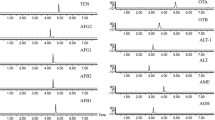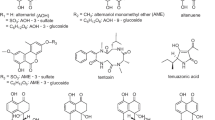Abstract
Validation of simple and rapid method for three Alternaria mycotoxins determination including alternariol (AOH), alternariol methyl ether (AME) and tentoxin (TEN) in strawberries is described. The extraction procedure was based on a simple liquid–liquid extraction with ethyl acetate, which provided the highest recoveries and the lowest matrix effect. Analytes were determinated by liquid chromatography coupled with tandem mass spectrometry (LC–MS/MS). The obtained relative recoveries were higher than 63 % for the studied mycotoxins in strawberries at the limit of quantification (LQ). Good linearity (r 2 > 0.993) and quantification limits (3–14 ng/g) were obtained. Repeatability, expressed as relative standard deviation, was always lower than 6 %, whereas interday precision was lower than 13 % for the developed method. The method was applied to analyse 24 strawberry samples commercialized in markets of the Valencia city (Spain). Analysed samples were only contaminated with AOH and AME.





Similar content being viewed by others
References
Ackermann Y, Curtui V, Dietrich R, Gross M, Latif H, Märtlbauer E, Usleber E (2012) Widespread occurrence of low levels of alternariol in apple and tomato products, as determined by comparative immunochemical assessment using monoclonal and polyclonal antibodies. J Agr Food Chem 59:6360–6368
Andersen B, Thrane U (2006) Food-borne fungi in fruit and cereals and their production of mycotoxins. In: Hocking AD, Pitt JI, Samson RA, Thrane U (eds) Advances in food mycology, advances in experimental medicine and biology, vol. 571. Springer-Verlag, Berlin, pp. 137–152
Andersen B, Krøger E, Roberts RG (2002) Chemical and morphological segregation of Alternaria arborescens, A. infectoria and A. tenuissima species-groups. Mycol Res 106:170–182
Barkai-Golan R, Paster N (2008) Alternaria mycotoxins. In: Mycotoxins in fruits and vegetables. Academic Press
Brugger EM, Wagner J, Schuhmacher DM, Koch K, Podlech J, Metzler M, Lehmann L (2006) Mutagenicity of the mycotoxin alternariol in cultured mammalian cells. Toxicol Lett 164:221–230
Commission Decision No. 2002/657/EC of 12 August 2002 implementing Council Directive 96/23/EC concerning the performance of analytical methods and the interpretation of results. Off J Eur Comm L221:8–36
Drusch S, Ragab W (2003) Mycotoxins in fruits, fruit juices and dried fruits. J Food Prot 66(8):1514–1527
EFSA European Food Safety Authority (2011) Scientific opinion on the risks for animal and public health related to the presence of Alternaria toxins in feed and food. EFSA J 9(10):2407
FAOSTAT consulted in August 2014 http://faostat.fao.org/site/368/DesktopDefault.aspx?PageID=368#ancor
Fernández-Cruz ML, Mansilla Marcia L, Tadeo JL (2010) Mycotoxins in fruits and their processed products: analysis, occurrence and health implications. J Adv Res 1:113–122
Greco M, Patriarca A, Terminiello L, Fernandez Pinto V, Pose G (2012) Toxigenic Alternaria species from Argentinean blueberries. Int J Food Microbiol 154:187–791
Jensen B, Knudsen IMB, Andersen B, Fog Nielsen K, Thrane U, Jensen DF, Larsen J (2013) Characterization of microbial communities and fungal metabolites on field grown strawberries from organic and conventional production. Int J Food Microbiol 160:313–322
Juan C, Ritieni A, Mañes J (2012) Determination of trichothecenes and zearalenones in grain cereal, flour and bread by liquid chromatography tandem mass spectrometry. Food Chem 134:2389–2397
Lehmann L, Wagner J, Metzler M (2006) Estrogenic and clastogenic potential of the mycotoxin alternariol in cultured mammalian cells. Food Chem Toxicol 44:398–408
Logrieco A, Visconti A, Bottalico A (1990) Mandarin fruit rot caused by Alternaria alternata and associated mycotoxins. Plant Dis 74(6):415–417
Logrieco A, Moretti A, Solfrizzo M (2009) Alternaria toxins and plant diseases: an overview of origin, occurrence and risks. World Mycotoxin J 2:129–140
Ostry V (2008) Alternaria mycotoxins: on overview of chemical characterization, producers, toxicity, analysis and occurrence in foodstuffs. World Mycotoxin J 1:175–188
Patriarca A, Azcarate MP, Terminiello L, Fernández Pinto V (2007) Mycotoxin production by Alternaria strains isolated from Argentinean wheat. Int J Food Microbiol 119:219–222
Polizzotto R, Andersen B, Martini M, Grisan S, Assante G, Musetti R (2012) A polyphasic approach for the characterization of endophytic Alternaria strains isolated from grapevines. Int J Food Microbiol 88:162–171
Tiemann U, Tomek W, Schneider F, Müller M, Pöhland R, Vanselow J (2009) The mycotoxins alternariol and alternariol methyl ether negatively affect progesterone synthesis in porcine granulosa cells in vitro. Toxicol Lett 186:139–145
Scott PM (2001) Analysis of agricultural commodities and foods for Alternaria mycotoxins. J AOAC Int 84:1809–1817
Somma S, Pose G, Pardo A, Mule G, Pinto VF, Moretti A, Logrieco AF (2011) AFLP variability, toxin production, and pathogenicity of Alternaria species from Argentinean tomato fruits and puree. Int J Food Microbiol 145:414–419
Strange RN (2007) Phytotoxins produced by microbial plant pathogens. Nat Prod Rep 24:127–144
Van de Perre E, Deschuyffeleer N, Jacxsens L, Vekeman F, Van Der Hauwaert W, Asam S, Rychlik M, Devlieghere F, De Meulenaer B (2014) Screening of moulds and mycotoxins in tomatoes, bell peppers, onions, soft red fruits and derived tomato products. Food Control 37:165–170
Acknowledgments
This work was financially supported by the Spanish Ministry of Science and Innovation (AGL2013-43194-P).
Author information
Authors and Affiliations
Corresponding author
Ethics declarations
Funding
This study was funded by the Spanish Ministry of Science and Innovation (AGL2013-43194-P).
Conflict of Interest
Cristina Juan declares that she has no conflict of interest. Khaoula Chamari declares that she has no conflict of interest. Souheib Oueslati declares that he has no conflict of interest. Jordi Mañes declares that he has no conflict of interest. This is an original research article that has neither been published previously nor considered presently for publication elsewhere. All authors named in the manuscript are entitled to the authorship and have approved the final version of the submitted manuscript.
Ethical Approval
This article does not contain any studies with human or animal subjects.
Informed Consent
Not applicable
Rights and permissions
About this article
Cite this article
Juan, C., Chamari, K., Oueslati, S. et al. Rapid Quantification Method of Three Alternaria Mycotoxins in Strawberries. Food Anal. Methods 9, 1573–1579 (2016). https://doi.org/10.1007/s12161-015-0338-9
Received:
Accepted:
Published:
Issue Date:
DOI: https://doi.org/10.1007/s12161-015-0338-9




